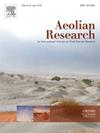Exploring the atmospheric and ecological impacts of a major dust storm: Insights from WRF–Chem simulations
IF 3.4
3区 地球科学
Q2 GEOGRAPHY, PHYSICAL
引用次数: 0
Abstract
Sand and dust storm (SDS) is disastrous weather phenomenon on a global scale. Previous studies have demonstrated that SDS significantly affects weather, air quality, and human health. However, the interaction between SDS and ecological systems has previously been underexplored. In this study, we aim to elucidate the impact mechanisms of SDS on vegetation dynamics. We employed Weather Research and Forecast (WRF) model with Chemistry (WRF–Chem) to investigate the severe SDS in East Asia in May 2017. Our results reveal that the WRF–Chem model reasonably reproduced the large scale eastward movement of the SDS caused by the Mongolia cyclone in multiple aspects. SDS decreased downward shortwave (SW) radiation at surface (DSWS) and increased longwave radiation at the surface, causing non-uniform spatiotemporal changes in skin temperature (SKT) determined by the local surface energy balance. Crucially, SDS detrimentally impacted gross primary production (GPP) during the critical germination phases, with reductions in GPP exceeding 10% in certain areas. The total reductions were −20.17 kt, −81.55 kt, and −218.88 kt, respectively for May 2, 3, and 4 over the domain. Changes in GPP were attributed to variations in SKT and DSWS, as determined by calculating the partial correlation coefficients (PCC). The sensitivity, magnitude, and direction of GPP variation due to SKT and DSWS were influenced by altitude, which inherently affects radiation levels. These variations were further modulated by local conditions, including moisture availability. Our study illuminates the interaction between SDS and ecological systems, a subject that has been poorly understood.
探索大沙尘暴对大气和生态的影响:来自WRF-Chem模拟的见解
沙尘暴是全球性的灾害性天气现象。以前的研究表明,SDS显著影响天气、空气质量和人类健康。然而,SDS与生态系统之间的相互作用尚未得到充分的研究。在本研究中,我们旨在阐明SDS对植被动态的影响机制。我们采用天气研究与预报(WRF)模型和化学(WRF - chem)模型对2017年5月东亚地区的严重SDS进行了研究。结果表明,WRF-Chem模式在多个方面合理再现了蒙古气旋引起的SDS大尺度东移。SDS降低了地表向下的短波(SW)辐射,增加了地表的长波辐射,导致由局部地表能量平衡决定的皮肤温度(SKT)时空变化不均匀。重要的是,在关键发芽期,SDS对总初级产量(GPP)产生不利影响,某些地区的GPP下降幅度超过10%。5月2日、3日和4日的总减少量分别为- 20.17 kt、- 81.55 kt和- 218.88 kt。GPP的变化归因于SKT和DSWS的变化,这是通过计算偏相关系数(PCC)确定的。由SKT和DSWS引起的GPP变化的敏感性、幅度和方向受海拔高度的影响,而海拔高度本身也会影响辐射水平。这些变化受到当地条件的进一步调节,包括水分的可用性。我们的研究阐明了SDS和生态系统之间的相互作用,这是一个知之甚少的主题。
本文章由计算机程序翻译,如有差异,请以英文原文为准。
求助全文
约1分钟内获得全文
求助全文
来源期刊

Aeolian Research
GEOGRAPHY, PHYSICAL-
CiteScore
7.10
自引率
6.10%
发文量
43
审稿时长
>12 weeks
期刊介绍:
The scope of Aeolian Research includes the following topics:
• Fundamental Aeolian processes, including sand and dust entrainment, transport and deposition of sediment
• Modeling and field studies of Aeolian processes
• Instrumentation/measurement in the field and lab
• Practical applications including environmental impacts and erosion control
• Aeolian landforms, geomorphology and paleoenvironments
• Dust-atmosphere/cloud interactions.
 求助内容:
求助内容: 应助结果提醒方式:
应助结果提醒方式:


